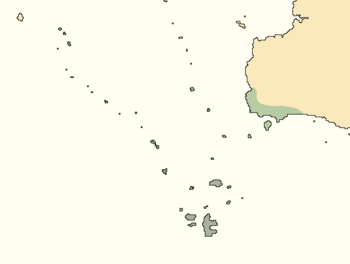Milevic Empire
Milevic Empire Cāyapūn Mēleḍīl (CZS) | |||||||||||
|---|---|---|---|---|---|---|---|---|---|---|---|
 Milevic Empire in X CY at its greatest extent Vassals and areas of influence | |||||||||||
| Capital | Eresa | ||||||||||
| Common languages | |||||||||||
| Religion | Milevic faith (37th–38th centuries CY) Kunwidya | ||||||||||
| Demonym(s) | Milevic | ||||||||||
| Government | Elective monarchy | ||||||||||
| Grand Steward | |||||||||||
• W–X CY | Name I | ||||||||||
• Y–Z CY | What's 9+10 | ||||||||||
| History | |||||||||||
• Established | ca. 3620 CY | ||||||||||
• Collapse | ca. 4100 CY | ||||||||||
| Currency | Yekhyic | ||||||||||
| |||||||||||
The Milevic Empire was a somewhat loose confederation of Milevic chiefdoms in northeastern Yazland. It existed from the 3620s CY until its collapse in the 42nd century.
The empire was founded upon and organised around a unique system of clans and sodalities wherein ruling clans of chiefdoms would band together regardless of kin to form a guild that performed a certain function (for example, a fishing sodality). This was a voluntary association as opposed to a system of vassalage, and as such the individual chiefdoms enjoyed a great degree of autonomy prior to the later years of the empire. Within the empire this system allowed regions to become specialised in the provision of a particular good or service.
Etymology
History
Establishment
Spread of Kunwidya
Collapse
Geography
Politics
Administrative Divisions
The empire was divided into a multitude of individual chiefdoms, each headed by a different ruling clan.
Government
Each chiefdom within the confederation was placed in a regional grouping overseen by a steward elected by the clans in a region, usually from their own ranks, who would oversee business and trade and resolve disputes between the clans under their jurisdiction. In the later stages of the empire these regions became de facto provinces, while the chiefdoms played a role more akin to districts within them.
In addition to regional stewards, every ruling clan would occasionally elect a grand steward, a de facto emperor.
